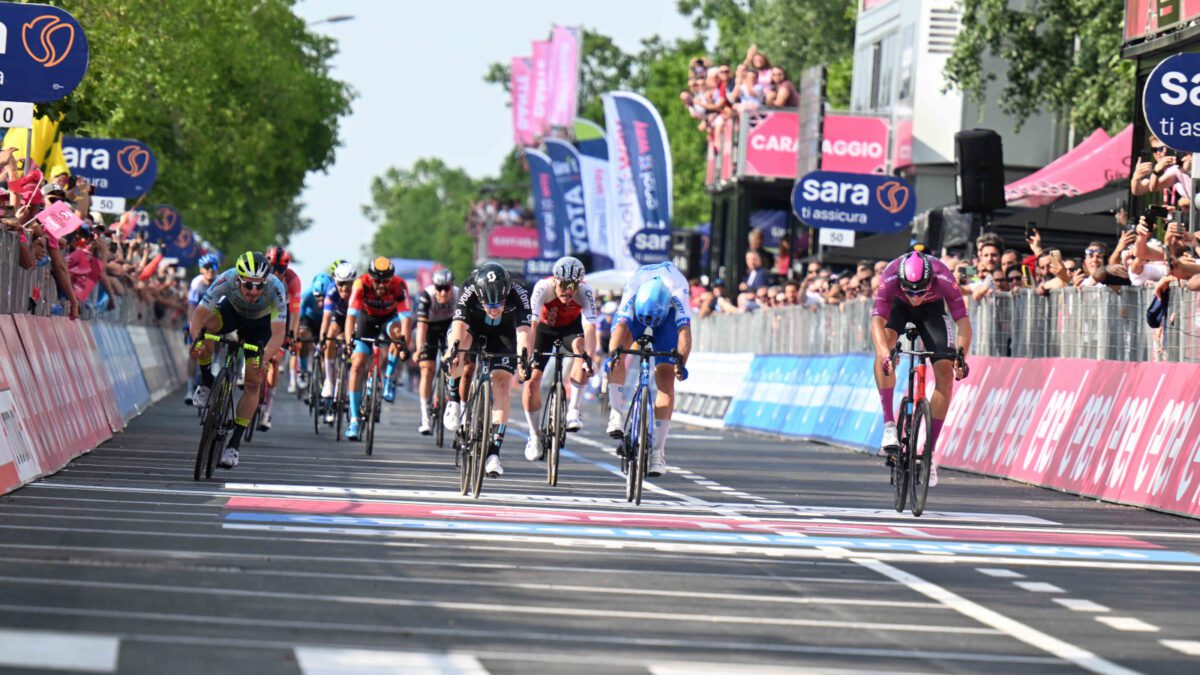How do pro leadout trains work (and why you may not always need one)
Gain insider insights into final sprints from the former national champion
 Photo by:
Sirotti
Photo by:
Sirotti
If you’ve been following the Giro d’Italia or any pro men’s and women’s races, you’ve most likely witnessed the remarkable efficiency of leadout trains. Have you ever been amazed by a pro rider emerging from the peloton, surging ahead in the closing moments of a gruelling road race, and claiming victory? The synchronized beauty of a leadout train unfolds as each team’s riders take turns, peeling off one by one, perfectly positioning their sprinter for the final sprint with just a few hundred meters to go. Typically, the top teams start organizing with 5 or 10 km to go, intensifying their efforts in the final 2 km. The last rider in the leadout is essentially a sprinter themselves, sprinting full throttle before the final kick.
Assembling the leadout train
Gord Fraser, one of Canada’s fastest pro sprinters ever, winessed countless leadouts throughout his career. “I didn’t experience a proper leadout until I joined the Mercury team. In the first year, Julian Dean was our go-to leadout man. He moved on to US Postal, and the following year, we had a rotation of Mike Sayers, Derek Bouchard Hall, and John Peters,” he explains. “The next year, Henk Vogels became our primary leadout rider, with Baden Cooke joining as well. In 2001, the standout year for Mercury, we had the incredible leadout duo of Henk Vogels and Jans Koerts. The following year, Graeme Miller came on board to support Vogels and Sayers.”
SOUND ?!! "Left, left, LEFT!!"…
How about this for a #ThrowbackThursday. That time @AdamBlythe89 took us for a high-adrenaline, edge-of-the-seat ride through the peloton as part of @CalebEwan's sprint leadout #Cycling #VelonLive pic.twitter.com/oU4uib5LwM
— Velon CC (@VelonCC) August 15, 2019
Coordinating the finale
Leadouts serve various crucial purposes, Fraser elaborates. In the closing kilometers, the team aims to keep their sprinter near the front and out of trouble. (Similar tactics are employed by GC teams leading up to climbs, with riders maintaining a high pace and the team leader positioned at the back of the train. As the climb begins, each cyclist peels off until the top climbers remain, supporting the highest-positioned rider in a favorable spot to counter attacks.)
“Many teams are incredibly well-coordinated, allowing the sprinter to conserve energy by simply following their train,” Fraser notes. This enables the designated sprinter to focus on their opponents amidst the often chaotic finale.
Honing your disaster-avoiding instincts while riding in a group
Pro teams will hire specific riders solely for the purpose of leadouts. Some riders even bring their leadout trains with them when transferring to other teams.
“Leadout men are exceedingly rare and valuable team players,” emphasizes Fraser. He cites current leadout riders like Michael Mørkøv and recently retired cyclist Mark Renshaw as some of the most impressive leadout specialists.
But what if a team lacks the strength to contest the leadout? What if the sprinter finds themselves alone, without a train to follow? Why don’t they simply latch onto their opponent’s wheel?
Turning over the pages of a how-to book on Professional Cycling, they should include Valcar’s leadout for Elisa on stage 6 as the blueprint on how this is done. No better example than this one. Of course it helps to have the sprinting legs of a WC to finish it off. @Elisa_balsamo pic.twitter.com/4GxYBlV6S6
— Phillip Martindale (@phillipm61) October 10, 2021
“Sprinters will indeed freelance in search of sprint trains,” explains the former national champion. Occasionally, teams can position another rider on their sprinter’s wheel to prevent this, but it can be challenging if they run out of available riders. That’s why the starting point of the train becomes crucial, although Fraser points out that it’s not always clearly defined. “Sometimes it happens organically,” he states. Although sometimes teams may discuss it beforehand after examining the course map.
That being said, it’s not always an exact science. “There is no ideal rendezvous point, despite all the best planning and map searches,” he warns. “Teams run the risk of over-analyzing and filling their heads with too much information. The most important thing is a sprinter you want to fight for!”
Great win for @EthanVernon22 ? what an awesome leadout btw. The Wolfpack is back! @soudalquickstep #Cycling #ChallengeMallorca pic.twitter.com/WAlUSi9y5l
— Chasse-Patate (@ChassePatate3) January 29, 2023
However, starting too early poses risks. “There’s a chance of running out of riders, leaving the sprinter isolated,” Fraser cautions. “If the leadout train falters or the team disintegrates, the sprinter might have to surf other trains.”
Timing is everything with a leadout
Thus, determining the starting point of the leadout depends on various factors. “It also depends on how many riders you have and how many are willing to commit to the leadout,” he adds. “The whole idea is to remove decisions and efforts from the sprinter.”
Fraser also highlights that the earlier a team takes the front, the more likely other teams will allow them to, recognizing that your team may shoulder the majority of the work. Therefore, assembling a robust leadout squad becomes paramount.
“It’s crucial that all the pieces are interchangeable, so the team instinctively knows who’s too fatigued and can swap positions on the fly,” he concludes.
So, the next time you tune in to a professional race, appreciate the meticulous organization and strategic maneuvers happening at speeds of 50-60 km/h!
